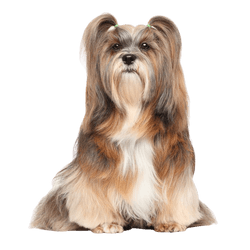Facts & Origin
Origin and history
The Rat Apso, a charming mix of Lhasa Apso and Rat Terrier, is a hybrid dog breed. Its parent breeds have a rich and remarkable history.
The Lhasa Apso, originally from Tibet, was considered a good luck charm and holy dog of the temples. On the other hand, the Rat Terrier, with roots in Britain and the United States, was originally bred for rat hunting.
The exact origin of the Rat Apso remains uncertain, as many designer dog breeds are often accidental crosses. Nevertheless, this breed is popular among dog lovers for its friendliness, energy, and alertness.
Suitability and attitude
Rat Apsos are wonderful for a variety of living situations - from apartments to houses with large yards. They are quite active and needdaily physical and mental exercise to stay happy and healthy.
Despite their small size, Rat Apsos are hardy with a strong hunting instinct, a trait they inherited from their Rat Terrier parent. However, at the same time, they are loving and loyal pets that bond quickly with their owners.
| Alternate Name | - |
| Origin | Tibet - USA |
| Life expectancy | 12 - 18 years |
| Care requirements | high-maintenance - low-maintenance |
| Activity level | low - average |
| FCI group | not recognised |
| AKC group | not recognised |
| KC group | not recognised |
More Lhasa Apso mixes
More American Rat Terrier mixes
Attitude, character and temperament of the breed
Character and personality
The Rat Apso is an energetic, playful and loving dog. It brings together the fun-loving nature of the Rat Terrier and the stoic dignity of the Lhasa Apso to create a loyal companion that delights both children and adults. They are outgoing, intelligent and easy to train, making them an ideal choice for first-time owners.
Behavior and Socialization
The Rat Apso is a social dog that enjoys spending time with their family. They are friendly with other pets and strangers, although they can be a bit shy at times. Their territorial attitude and guarding instincts, inherited from the Rat Terrier, make them great watchdogs.
Character
Care of the Rat Apsos
The coat care of a Rat Apsos can vary depending on which parent it more closely resembles. Generally, the coat length is medium to long and requires regular brushing to prevent matting. Bathing and grooming should be done as needed to keep the coat clean and healthy.
Regular ear and dental cleanings are also required to prevent infections and dental problems. Also make sure he gets enough exercise and gets a balanced diet.
Health and Diseases
Council Apsos are generally healthy, but can be genetically prone to certain conditions. These include eye problems, hip dysplasia, and some skin conditions. Regular vet visits and preventative care are essential to ensure the dog's health.
With proper nutrition and regular exercise, the Rat Apso can reach a life expectancy of 12 to 15 years.
Breeding the Rat Apso
A responsible bre eder will always pay attention to the health of the parents. Both breeds, Lhasa Apso and Rat Terrier, should be tested for possible genetic diseases before considering breeding.
Careful selection of parent animals will help ensure the health and temperament of the offspring. Good socialization and training from puppyhood are critical to raising a well-behaved, confident and happy dog.
What does this mixed breed look like?
The Rat Apso is one of the small to medium sized dogs. Visually, it resembles the Lhasa Apso a bit more with its longer coat, but can also have the slimmer stature of the Rat Terrier.
He usually has deep-set eyes and a black nose. His ears are often medium-sized and drop a bit, giving his face a charming expression. However, due to its genetic diversity, the Rat Apso may exhibit characteristics of both parent breeds.
The Rat Apso's coat is usually medium to long and can be curly or smooth. It can come in a variety of colors, including white, black, brown, beige, and gray, as well as combinations of these.
| Fur length | long - short |
| Fur | flat coated |
| Ear shape | Floppy Ear - Standing Ears |
| Tail | rolled up - stubby |
| Anatomy | slim, slim |
| Size ♀ | 20 - 46 cm |
| Weight ♀ | 5 - 16 kg |
| Size ♂ | 20 - 46 cm |
| Weight ♂ | 5 - 16 kg |
| Suitable For | Beginner, Children, Seniors, Children |
Known Diseases
Hip dysplasia (HD)
Hip dysplasia (HD) is a genetic condition in dogs where the hip joint is not shaped properly. This leads to pain, stiffness and restricted movement.
Eye diseases
Often occur with allergies and intolerances.
Patellar luxation
Patellar luxation is the term used to describe a displacement of the kneecap, which is one of the most common causes of lameness in dogs.
FAQ
-
These mixed breeds are intelligent, loyal and playful dogs. They are very loyal and love to be with their family and spend a lot of time with them.
-
Yes, this dog can be prone to respiratory diseases, eye problems, and hereditary diseases that weaken their immune system, making them susceptible to allergies and other problems. Regular checkups with a veterinarian and a healthy diet will help minimize these problems.
-
Yes, Council Apsos can be very active and need plenty of activity to keep them happy and healthy.





















